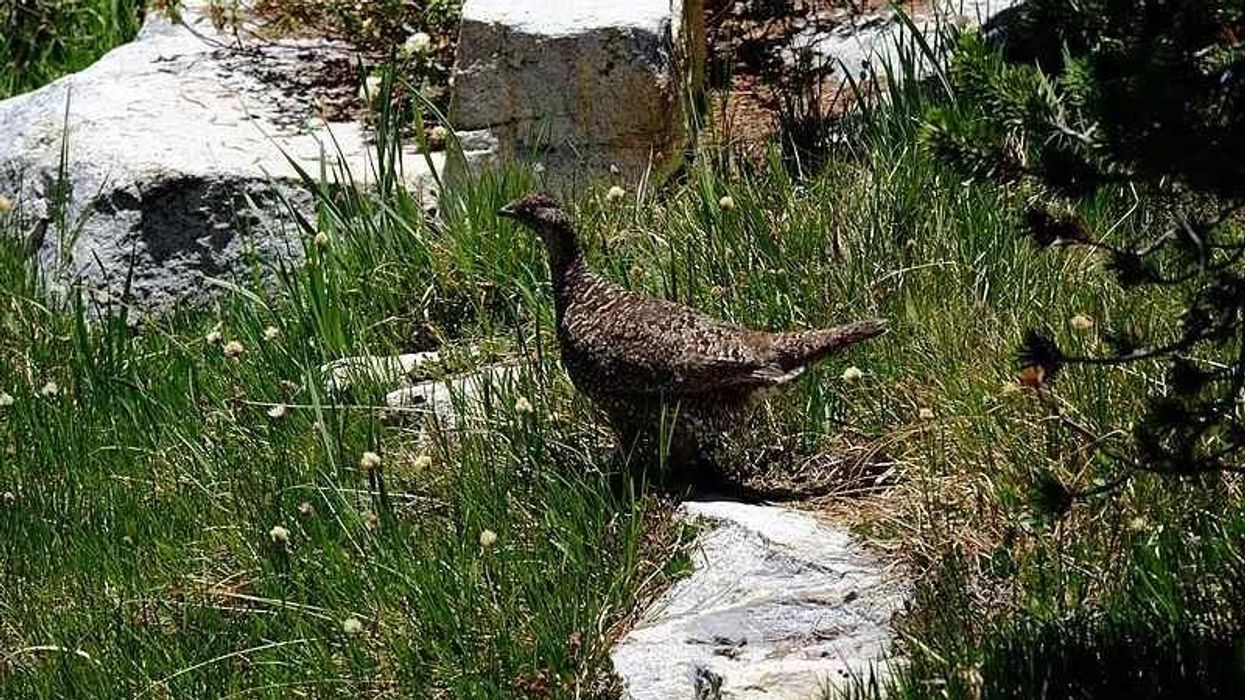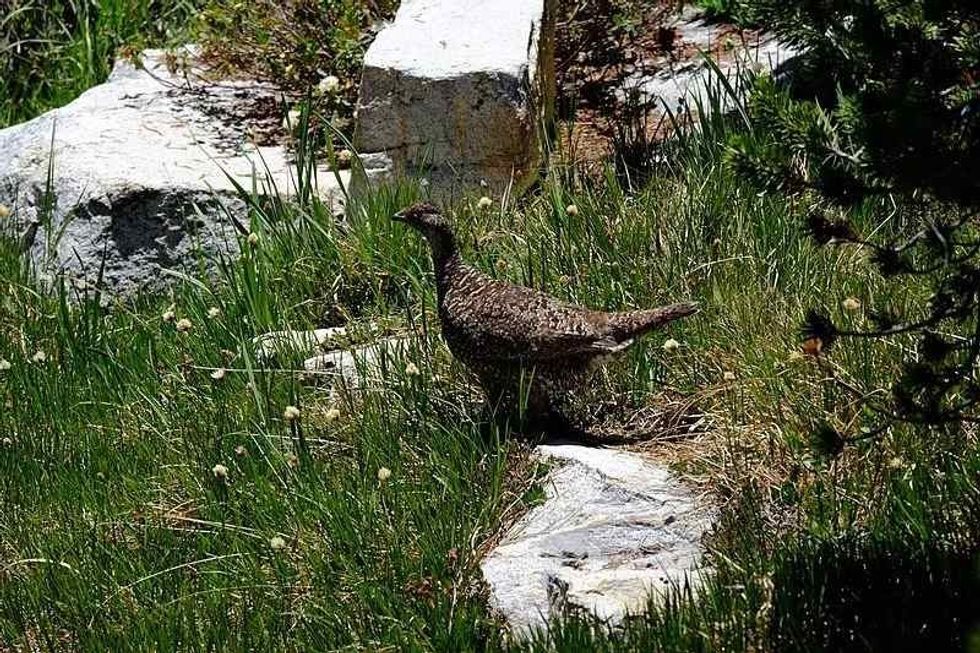Grouse is a species of bird in the order Galliformes, family Phasianidae. The sooty grouse (Dendragapus fuliginosus) is one of six kinds of grouse.
The American Ornithologists' Union separated the formerly known blue grouse species into two species in 2006: dusky grouse and sooty grouse. The two new species are the same size and closely resemble one another. The sooty bird is one of North America's biggest grouse and was previously classified as a subspecies of the blue grouse.
If you are interested in browsing through some more interesting facts about these North American birds with air sacs in the neck, then read on. Afterward, do check our other articles on grouse facts and spruce grouse facts.
Sooty Grouse Interesting Facts
What type of animal is a Sooty Grouse?
Sooty Grouse is a species of forest grouse in North America. In summer, these grouse are known to hoot females to lure them for copulation, like other similar species.
What class of animal does a Sooty Grouse belong to?
As per the Cornell Lab of Ornithology, the sooty grouse belongs to a species of bird in the order Galliformes, family Phasianidae, and has several other similar species.
How many Sooty Grouse are there in the world?
Partners in flight estimate a global breeding population of 2 million birds and classify the species as 13 out of 20 on the Continental Concern Scale, suggesting that it is of low conservation concern. Nonetheless, if the present decrease rates continue, the species will have lost half of its population by 2088.
Where does a Sooty Grouse live?
Most types of forest habitats in North America support one or more grouse bird species. These North American bird species may be found in the United States, from Alaska's subarctic areas to Texas' grasslands.
The majority of grouse are non-migratory (like magpies). This implies these birds spend the entire year in the same environment. If you wish to locate these birds in their habitat in the wild and know their bird id, get hold of a bird guide.
These birds forage on the ground, or in trees in winter. In winter, they mainly eat fir.
What is a Sooty Grouse's habitat?
Sooty grouse live in coniferous forests predominantly in hilly locations, although these bird species also breed in woods around sea level in the northern half of their range. Most breeding habitats are open woods, and sooty grouse prefers both old-growth forests with gaps and recovering logged or burnt regions with an abundance of grasses and bushes.
They spend their time equally up the trees as well as on the ground.
Who do Sooty Grouse live with?
Sooty grouse species are normally found alone near trees rather than in groups (except for hens with young, and are normally cautious while roaming around the forests. To access more information about their natural habitat and their bird features, you can use a bird guide dedicated to North American birds.
How long does a Sooty Grouse live?
Sooty grouse have a relatively short lifespan range, with half of them dying in the first year in the forest. Sooty grouse who survive the first year have a three-year lifetime on average in forests. Birds have been known to live for up to 14 years in forest areas with plenty of food and no prey.
How do they reproduce?
The breeding season of sooty grouse usually occurs during spring or summer and starts with male sooty grouse displaying itself from trees to attract females during the breeding season, whereas the closely related dusky grouse displays mostly from the ground. After the pairs have been formed, the sexual mating process takes place.
After the breeding process is over, the female looks for a protective cover for the nest. Females lay around 2-12 eggs in the nest during the breeding season.
The incubation period lasts for around 25-28 days after which the young chicks hatch.
Both the male and female birds take care of the young birds while they remain in the nest. The young birds stay in the nest till they have grown their wings and are old enough to fend for themselves.
What is their conservation status?
Sooty grouse bird populations decreased by around 1.8% each year between 1968 and 2015, resulting in a 57% loss during that period, according to the North American Breeding Bird Survey. The causes behind Sooty Grouse's seeming quick fall are mostly unexplained.
Even though they still inhabit most of their historical range, sooty grouse have vanished in areas where development has removed forest for homes or farmland, such as in western Washington.
As per IUCN, their conservation status is of least concern at present. But concerted conservation efforts are required to maintain their populations.
Sooty Grouse Fun Facts
What do sooty grouse look like?
Both males and females are camouflaged with brown, grey, white, and black patterns. Males have darker grey tails and lighter grey underparts than females.
Males show yellowish air sacs on their necks during display, and their eye combs expand and turn a beautiful yellow-orange color. They are named after their tail feathers and the pattern on those feathers in the tail.
Adults have a long square tail, light gray at the end. Adult males have dark plumage with a yellow throat air sac covered by a white and yellow wattle over the eye.
How cute are they?
Sooty grouse are stunning. The color pattern on their necks makes them more appealing to the eye.
How do they communicate?
Male sooty grouse hoots communicate in the middle of the summer to lure females who have lost their clutch and are ready to mate again.
How big is a Sooty Grouse?
Sooty grouse are three times bigger than the common quail as per the Cornell Lab of Ornithology. The average sooty grouse height range varies from 15.8-19.7 in (40.1-50 cm).
How fast can a Sooty Grouse fly?
Sooty grouse can take short flights at speeds of up to 70 mph (112 kph) while flying close to the ground and sometimes changing course at the last second.
How much does a Sooty Grouse weigh?
As per the Cornell Lab of Ornithology, the blue grouse weight range is 1.1-2.2 lb (0.49-0.99 kg).
What are the male and female names of the species?
There is no particular or stated name for the male and female sooty grouse. They are differentiated by the fact that males of this species are slate grey mixed with white, while females are greyish-brown mixed with white. On males, the eye comb is yellowish-orange and occupies the whole upper half of the eye.
What would you call a baby Sooty Grouse?
A Sooty Grouse baby bird is known as a young or juvenile Sooty Grouse.
What do they eat?
Sooty grouse eatleaves, flowers, buds, nuts, and conifer needles, as well as a variety of insects. Young birds can consume more insects than adults. During winter, it mostly feeds on the needles of conifers such as pines, hemlocks, firs, and Douglas-firs.
Are they dangerous?
Sooty grouse are not always physically aggressive (most birds aren't due to the danger of self-injury), but they are very territorial, particularly during nesting season.
Would they make a good pet?
No, these birds are supposed to be out in the open. The circumstances in a domesticated cage are unsuitable for a sooty grouse.
Did you know...
Most bird species have a certain number of tail feathers (rectrices), which is generally about ten. The sooty grouse, on the other hand, can have anywhere from 15-22.
The sooty grouse is North America's third-biggest grouse and one of the world's biggest. The only bigger American grouse species are the two sage-grouse species (Greater and Gunnison).
What is the difference between a Sooty Grouse and a Spruce Grouse?
A male sooty grouse is bigger than spruce grouse and are dark in color rather than black with white markings. The tail of the sooty grouse is pale-tipped, while the tail of the spruce grouse is all black or tipped with orange.
What trees do grouse like?
Lodgepole pine tree, limber pine tree, mountain hemlock tree, western hemlock, Douglas-fir, subalpine fir, white fir, Engelmann spruce, Sitka spruce, and western red cedar tree, among other pine species, are favorites of the sooty grouse.
Here at Kidadl, we have carefully created lots of interesting family-friendly animal facts for everyone to discover! For more relatable content, check out these greater sage-grouse facts or hummingbird facts.
You can even occupy yourself at home by coloring one of our grouse coloring pages.










